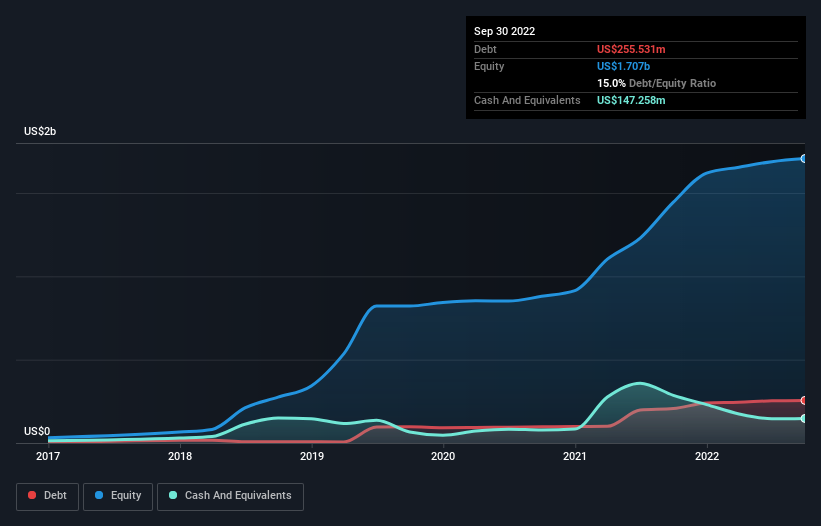Green Thumb Industries (CSE:GTII) Seems To Use Debt Quite Sensibly
Warren Buffett famously said, 'Volatility is far from synonymous with risk.' It's only natural to consider a company's balance sheet when you examine how risky it is, since debt is often involved when a business collapses. Importantly, Green Thumb Industries Inc. (CSE:GTII) does carry debt. But is this debt a concern to shareholders?
When Is Debt Dangerous?
Debt is a tool to help businesses grow, but if a business is incapable of paying off its lenders, then it exists at their mercy. Ultimately, if the company can't fulfill its legal obligations to repay debt, shareholders could walk away with nothing. While that is not too common, we often do see indebted companies permanently diluting shareholders because lenders force them to raise capital at a distressed price. Of course, the upside of debt is that it often represents cheap capital, especially when it replaces dilution in a company with the ability to reinvest at high rates of return. The first thing to do when considering how much debt a business uses is to look at its cash and debt together.
Check out our latest analysis for Green Thumb Industries
What Is Green Thumb Industries's Debt?
The image below, which you can click on for greater detail, shows that at September 2022 Green Thumb Industries had debt of US$255.5m, up from US$206.5m in one year. However, it does have US$147.3m in cash offsetting this, leading to net debt of about US$108.3m.

How Healthy Is Green Thumb Industries' Balance Sheet?
The latest balance sheet data shows that Green Thumb Industries had liabilities of US$129.4m due within a year, and liabilities of US$619.6m falling due after that. Offsetting these obligations, it had cash of US$147.3m as well as receivables valued at US$30.6m due within 12 months. So it has liabilities totalling US$571.2m more than its cash and near-term receivables, combined.
Of course, Green Thumb Industries has a market capitalization of US$3.12b, so these liabilities are probably manageable. But there are sufficient liabilities that we would certainly recommend shareholders continue to monitor the balance sheet, going forward.
In order to size up a company's debt relative to its earnings, we calculate its net debt divided by its earnings before interest, tax, depreciation, and amortization (EBITDA) and its earnings before interest and tax (EBIT) divided by its interest expense (its interest cover). This way, we consider both the absolute quantum of the debt, as well as the interest rates paid on it.
Green Thumb Industries has a low net debt to EBITDA ratio of only 0.34. And its EBIT covers its interest expense a whopping 12.1 times over. So you could argue it is no more threatened by its debt than an elephant is by a mouse. Fortunately, Green Thumb Industries grew its EBIT by 9.1% in the last year, making that debt load look even more manageable. When analysing debt levels, the balance sheet is the obvious place to start. But ultimately the future profitability of the business will decide if Green Thumb Industries can strengthen its balance sheet over time. So if you want to see what the professionals think, you might find this free report on analyst profit forecasts to be interesting.
Finally, a business needs free cash flow to pay off debt; accounting profits just don't cut it. So the logical step is to look at the proportion of that EBIT that is matched by actual free cash flow. Considering the last three years, Green Thumb Industries actually recorded a cash outflow, overall. Debt is usually more expensive, and almost always more risky in the hands of a company with negative free cash flow. Shareholders ought to hope for an improvement.
Our View
Green Thumb Industries's interest cover was a real positive on this analysis, as was its net debt to EBITDA. But truth be told its conversion of EBIT to free cash flow had us nibbling our nails. When we consider all the elements mentioned above, it seems to us that Green Thumb Industries is managing its debt quite well. Having said that, the load is sufficiently heavy that we would recommend any shareholders keep a close eye on it. The balance sheet is clearly the area to focus on when you are analysing debt. But ultimately, every company can contain risks that exist outside of the balance sheet. Case in point: We've spotted 1 warning sign for Green Thumb Industries you should be aware of.
Of course, if you're the type of investor who prefers buying stocks without the burden of debt, then don't hesitate to discover our exclusive list of net cash growth stocks, today.
New: Manage All Your Stock Portfolios in One Place
We've created the ultimate portfolio companion for stock investors, and it's free.
• Connect an unlimited number of Portfolios and see your total in one currency
• Be alerted to new Warning Signs or Risks via email or mobile
• Track the Fair Value of your stocks
Have feedback on this article? Concerned about the content? Get in touch with us directly. Alternatively, email editorial-team (at) simplywallst.com.
This article by Simply Wall St is general in nature. We provide commentary based on historical data and analyst forecasts only using an unbiased methodology and our articles are not intended to be financial advice. It does not constitute a recommendation to buy or sell any stock, and does not take account of your objectives, or your financial situation. We aim to bring you long-term focused analysis driven by fundamental data. Note that our analysis may not factor in the latest price-sensitive company announcements or qualitative material. Simply Wall St has no position in any stocks mentioned.
About CNSX:GTII
Green Thumb Industries
Manufactures, distributes, markets, and sells of cannabis products for medical and adult-use in the United States.
Adequate balance sheet and fair value.
Similar Companies
Market Insights
Community Narratives



